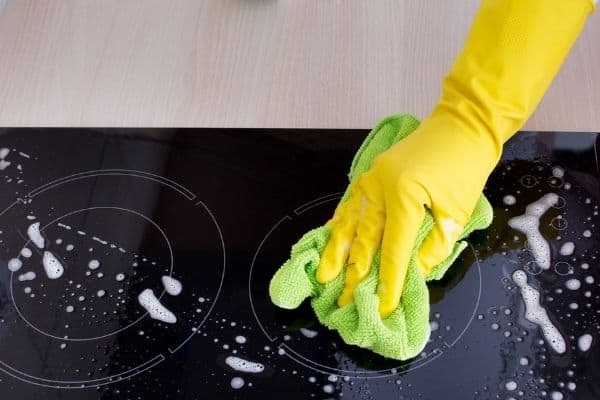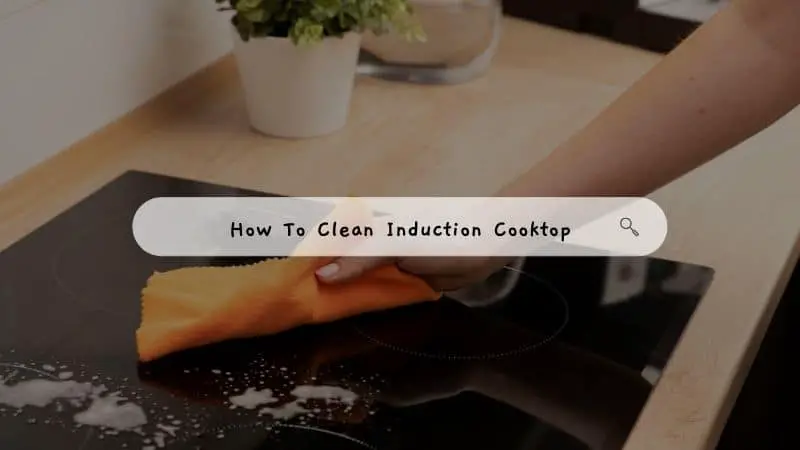Induction cooktops are the latest trend in cooking. The induction stovetop is easy to clean because it’s made of glass and doesn’t have any cracks where food can hide. With proper care, these cooktops will last a long time!
Induction cooktops need special cleaners that you can find at most stores with kitchenware sections. You should never use abrasive materials like steel wool or scouring pads on your glass surfaces. Instead, try using baking soda mixed with water for stubborn stains and spills.
If something has burned onto the surface, scrub it off as soon as possible before it seeps into the pores of the glass and becomes impossible to remove!
Induction Cooktops Are
An induction cooker or “induction cooktop” is a range of cooking stoves that uses electromagnetic fields to transfer heat directly to the cooking vessel, thus heating it rapidly.
This means they can bring water to boil quickly and maintain even simmering temperatures without the use of high-powered burners that generate excessive amounts of heat.
Why Is It Important To Clean An Induction Cooker?
As more people are switching from traditional cooking methods like gas stoves or ovens to induction sealed burner tops, housewives have started facing a unique problem:

How to clean the induction cooktop and how do you maintain it? One should not only keep the stove itself clean, but also ensure that there is no dirt or food particles left behind after cooking due to which the surface gets stained.
This leads to hardening of such dirt over time and can prove extremely difficult to remove once such stains get set in. To avoid this happening one must follow a regular cleaning pattern and use certain products for cleaning which are designed specifically for induction sealed burner tops.
How To Clean Induction Cooktop?
Daily cleaning method
Everyday cleaning is really simple. You can use regular dish soap, regular wet paper towels or you can even use a furniture spray made for stainless steel. Dry everything with a dry soft cloth. This prevents water spots from forming on the surface of your induction cooktop stove. Note that it is important to avoid abrasive material and chemicals completely as they may damage the glass-ceramic top and ruin the entire appliance so, you should not consider using them at all.
The advantages of doing this method are that you won’t be wasting time and it will also save money in the long run as well as keeping your sink clean and sparkling with no build-up of dirt which means there’s no food debris leftover.
Heavy cleaning method
If your induction cooktop is covered in grease, you may have a much bigger job on your hands. The grease will not only make the cooktop look dirty but it can also inhibit heat transfer from the pan to the cooktop surface.
Start by turning off your range and unplugging it from its power source. Next, use a damp cloth or kitchen sponge with a mild detergent to wipe down the entire cooking surface of the unit.
Additionally, take this opportunity to clean around any knobs and buttons that might be present on your model.
Once you have wiped the induction cooktop down, turn on your range and use a dry cloth or paper towel to remove any excess moisture from the surface of the range.
Be sure to turn off your range at this point before continuing.
Cleaning with the right product
There are many products which you can use to clean your induction cooktop. Some of them are really good some are bad. A list is given below:
Cleaning with vinegar & water solution
You can also try making up a cleaning paste with equal amounts of white distilled vinegar and baking soda. Apply the paste to the surface using a soft sponge or cloth and let it stand for about ten minutes before washing and then drying thoroughly. This is a good method as it helps to lift away the dirt and grime that may be left on the surface of your induction stovetop.
And if you use this solution, please do not use a wet paper towel as it can leave water spots behind as well as scratching the glass-ceramic top, which we don’t want at all! Instead, try using a soft cotton cloth or dish towel with lukewarm water and wipe off with a dry cloth.
The advantages are that it’s easy and simple way while cleaning but make sure you don’t leave stains behind by using soft cotton towel while wiping off with dry cloth. It is also good for removing grease, grime and burnt food residues perfectly if done correctly.
Clean induction cooktop with toothpaste
The best way to clean an induction cooktop is by using toothpaste. Many people are not familiar with this method though because they are afraid that it may scratch their stove’s surface.
However, this method has been proven to work best in removing stubborn stains on your induction cooktop caused by burnt food or stains left from steel wool when cleaning pots and pans which were previously used for oil-based dishes. Although you can use regular toothpaste, make sure that it does not contain any whit additives because these could leave white spots on the surface of your induction cooktop.
You can simply spread a thick layer of regular white toothpaste on the induction cooktop and wait for about five minutes. This allows time for the toothpaste to react with the stains on your stove’s surface.
Make sure that you use a damp sponge or paper towel when wiping off any leftover toothpaste from your stove’s surface after it has been left to set in for 5 – 10 minutes. Make sure not to scrub too hard as this will leave scratches on the induction cooktop’s surface and cause permanent damage, which is why we recommend using something soft like a sponge or paper towel.
Clean up melted plastic and melting sugar
Plastic containers may melt onto the surface of an induction cooktop if they are left too long or not carried to the sink immediately after use. Additionally, oil or grease from cooking may drip onto the surface and leave a sticky residue.
Both melted plastic and burned food debris can become nearly impossible to remove with water alone so it is important that you have either commercial cleaners specifically designed for induction ranges or items in your home that will assist in removing these contaminants before they harden into permanent stains. The longer you wait, however, the more difficult it will be to erase the stain entirely.
Things To Keep In Mind When Cleaning Induction Cooktop
It better if you can clean the induction cooktop regularly after each time you use it. However, if there are serious stains or dirt stuck onto your cooking base or hotplate surface, you can skip the regular way and go straight to deep cleaning method using vinegar solution. Please make sure that all parts of your cooking appliances are turned off and unplugged.
Before you do the deep cleaning, it is good to prepare a good ventilation as well as proper protection for yourself such as rubber gloves and goggles. You can use any household cleaner that does not contain dangerous acidic or alkaline chemicals.
Also avoid using caustic and abrasive substances to scrub your appliances as much as possible because they might damage the surface of your cooking appliances seriously.
Of course, since there are different types of materials used for Induction cooktops, some material might be more sensitive than others. Therefore if you think the method below only applies to ceramic materials or glass cooktops, please check with manual book first before doing it on your specific model.
Conclusion
Induction cooktops are a great way to prepare meals. However, they do require some care and maintenance in order for them to function properly over time. Cleaning induction cooktop is not as difficult as many would assume, but it does take a little bit of elbow grease with the right materials.
In this blog post we will detail how you can clean your own induction cooktop at home without having to call on an expensive professional service! What steps have you taken so far? Let us know by commenting below.
